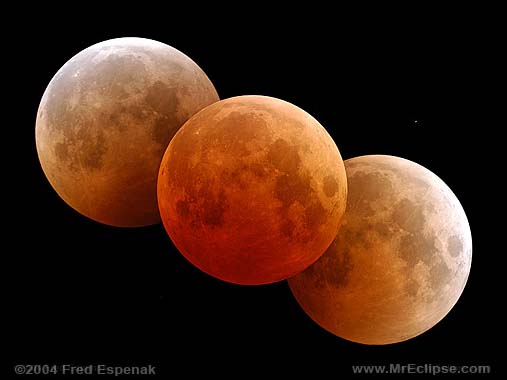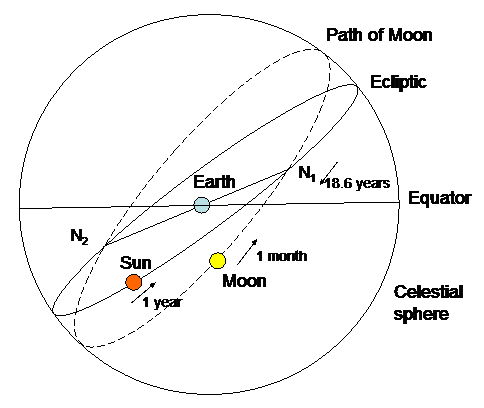
Total lunar eclipse composite image by Fred Espenak
A lunar eclipse happens when the Earth, sun and moon align in space, with Earth in between the sun and moon. At such times, Earth’s shadow falls on the full moon, causing a lunar eclipse.
A solar eclipse happens at the opposite phase of the moon – new moon – when the moon passes between the sun and Earth. Why aren’t there eclipses at every full and new moon?
The moon takes about a month to orbit around the Earth. If the moon orbited in the same plane as the ecliptic – Earth’s orbital plane – we would have two eclipses every month. There’d be an eclipse of the moon at every full moon. And, two weeks later, there’d be an eclipse of the sun at new moon for a total of at least 24 eclipses every year.
But the moon’s orbit is inclined to Earth’s orbit by about 5 degrees. Twice a month the moon intersects the ecliptic – Earth’s orbital plane – at points called nodes. If the moon is going from south to north in its orbit, it’s called an ascending node. If the moon is going from north to south, it’s a descending node. If the full moon or new moon is appreciably close to one of these nodes, then an eclipse is not only possible – but inevitable.

The plane of the moon’s orbit is inclined at 5 degrees to the ecliptic (Earth’s orbital plane). In this diagram, the ecliptic is portrayed as the sun’s apparent annual path through the constellations of the zodiac. The moon’s orbit intersects the ecliptic at two points called nodes (N1 and N2).
Solar and lunar eclipses always come in pairs, with one following the other in a period of one fortnight (approximately two weeks). For example, in 2018, the ascending node total lunar eclipse on January 31 was followed by a descending node partial solar eclipse on February 15.
Then exactly six lunar months (six full moons) after the ascending node total lunar eclipse on January 31, there’s a descending node total lunar eclipse on July 27. One fortnight before and after this July 27 total lunar eclipse, an ascending node partial solar eclipse happens on July 13 and again on August 11.
More often than not, two eclipses – one lunar and one solar – occur in one eclipse season, a period lasting somewhat longer than one calendar month. Sometimes, though, when the initial eclipse happens sufficiently early in the eclipse season, there can be three eclipses in this one eclipse season (two solar and one lunar, or two lunar and one solar).
This year, in 2018, the middle of the eclipse season happens on February 3 and July 28, 2018. At the middle of an eclipse season, which recurs in periods of about 173 days, the lunar nodes are in exact alignment with the Earth and sun.
Is it possible to have three eclipses in one month?
The video below explains why a pair of eclipses happens when the new moon and full moon are closely aligned with the lunar nodes.
There might be some unfamiliar words in this video, including ecliptic and node. The ecliptic is the plane of Earth’s orbit around the sun. The moon’s orbit is inclined to the plane of the ecliptic. The nodes are the two points where the moon’s orbit and the ecliptic intersect.
Relative to the moon’s phases, the nodes move about 30o westward (clockwise) along the ecliptic each month. So the next pair of eclipses won’t be forthcoming for nearly another six months, or until January 6 and January 21, 2019.
Node passages of the moon: 2001 to 2100
Phases of the moon: 2001 to 2100
Because the nodes move about 30o westward (clockwise) along the ecliptic each month, the eclipse season has a rather short duration. One lunar month after the eclipses of July 27 and August 11, 2018 – when the moon next crosses its descending and ascending nodes – it’ll be a waxing gibbous moon (not a full moon) that crosses the moon’s descending node on August 24, 2018, and a waning crescent moon (not a new moon) that crosses the moon’s ascending node on September 6, 2018.
Even though the moon’s orbit is inclined to that of Earth – and even though there’s not an eclipse with every full and new moon – there are more eclipses than you might think.
There are from four to seven eclipses every year. Some are lunar, some are solar, some are total, and some are partial. All are marvelous to behold – a reminder that we live on a planet – a chance to experience falling in line with great worlds in space!

Photo credit: pizzodisevo
from EarthSky https://ift.tt/2flrAt6

Total lunar eclipse composite image by Fred Espenak
A lunar eclipse happens when the Earth, sun and moon align in space, with Earth in between the sun and moon. At such times, Earth’s shadow falls on the full moon, causing a lunar eclipse.
A solar eclipse happens at the opposite phase of the moon – new moon – when the moon passes between the sun and Earth. Why aren’t there eclipses at every full and new moon?
The moon takes about a month to orbit around the Earth. If the moon orbited in the same plane as the ecliptic – Earth’s orbital plane – we would have two eclipses every month. There’d be an eclipse of the moon at every full moon. And, two weeks later, there’d be an eclipse of the sun at new moon for a total of at least 24 eclipses every year.
But the moon’s orbit is inclined to Earth’s orbit by about 5 degrees. Twice a month the moon intersects the ecliptic – Earth’s orbital plane – at points called nodes. If the moon is going from south to north in its orbit, it’s called an ascending node. If the moon is going from north to south, it’s a descending node. If the full moon or new moon is appreciably close to one of these nodes, then an eclipse is not only possible – but inevitable.

The plane of the moon’s orbit is inclined at 5 degrees to the ecliptic (Earth’s orbital plane). In this diagram, the ecliptic is portrayed as the sun’s apparent annual path through the constellations of the zodiac. The moon’s orbit intersects the ecliptic at two points called nodes (N1 and N2).
Solar and lunar eclipses always come in pairs, with one following the other in a period of one fortnight (approximately two weeks). For example, in 2018, the ascending node total lunar eclipse on January 31 was followed by a descending node partial solar eclipse on February 15.
Then exactly six lunar months (six full moons) after the ascending node total lunar eclipse on January 31, there’s a descending node total lunar eclipse on July 27. One fortnight before and after this July 27 total lunar eclipse, an ascending node partial solar eclipse happens on July 13 and again on August 11.
More often than not, two eclipses – one lunar and one solar – occur in one eclipse season, a period lasting somewhat longer than one calendar month. Sometimes, though, when the initial eclipse happens sufficiently early in the eclipse season, there can be three eclipses in this one eclipse season (two solar and one lunar, or two lunar and one solar).
This year, in 2018, the middle of the eclipse season happens on February 3 and July 28, 2018. At the middle of an eclipse season, which recurs in periods of about 173 days, the lunar nodes are in exact alignment with the Earth and sun.
Is it possible to have three eclipses in one month?
The video below explains why a pair of eclipses happens when the new moon and full moon are closely aligned with the lunar nodes.
There might be some unfamiliar words in this video, including ecliptic and node. The ecliptic is the plane of Earth’s orbit around the sun. The moon’s orbit is inclined to the plane of the ecliptic. The nodes are the two points where the moon’s orbit and the ecliptic intersect.
Relative to the moon’s phases, the nodes move about 30o westward (clockwise) along the ecliptic each month. So the next pair of eclipses won’t be forthcoming for nearly another six months, or until January 6 and January 21, 2019.
Node passages of the moon: 2001 to 2100
Phases of the moon: 2001 to 2100
Because the nodes move about 30o westward (clockwise) along the ecliptic each month, the eclipse season has a rather short duration. One lunar month after the eclipses of July 27 and August 11, 2018 – when the moon next crosses its descending and ascending nodes – it’ll be a waxing gibbous moon (not a full moon) that crosses the moon’s descending node on August 24, 2018, and a waning crescent moon (not a new moon) that crosses the moon’s ascending node on September 6, 2018.
Even though the moon’s orbit is inclined to that of Earth – and even though there’s not an eclipse with every full and new moon – there are more eclipses than you might think.
There are from four to seven eclipses every year. Some are lunar, some are solar, some are total, and some are partial. All are marvelous to behold – a reminder that we live on a planet – a chance to experience falling in line with great worlds in space!

Photo credit: pizzodisevo
from EarthSky https://ift.tt/2flrAt6

Aucun commentaire:
Enregistrer un commentaire